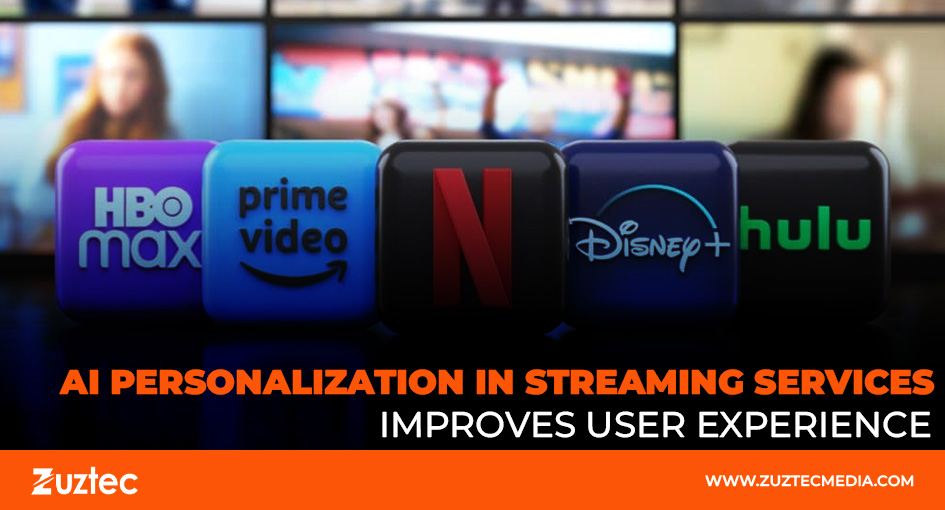
AI Personalization in Streaming Services Improves User Experience
The hub of digital entertainment is now streaming services. People use streaming services daily for everything from listening to music on Spotify to watching TV series on Netflix. But what makes these platforms so addictive and personalized? The answer lies in AI personalization—a powerful tool that uses artificial intelligence to improve user experience.
It refers to the use of machine learning and data analysis to recommend content based on a user’s habits and preferences. Instead of showing the same content to every user, AI looks at what each person watches or listens to, how long they engage with it, and how often they return. Based on this information, the system suggests content that fits their unique tastes.
Think of how Netflix knows what you might enjoy watching next or how Spotify builds playlists just for you. These personalized experiences are no accident—they’re the result of carefully designed AI algorithms working behind the scenes. These tools help platforms keep users engaged, reduce search time, and improve satisfaction.
AI personalization is becoming more crucial than ever as streaming services compete with one another. Companies want to stand out, and offering a tailored experience is one way to do it. In this article, we’ll explore how AI personalization in streaming services works, why it matters to users and companies, and what challenges it presents. We’ll also take a look at future trends and how this technology continues to evolve.
What Is AI Personalization in Streaming?
The process of tailoring content to each user according to their behavior is known as AI personalization. In streaming, this means collecting data such as watch history, viewing time, likes, and searches. The system then uses algorithms to find patterns and predict what the user might enjoy next.
For example, if you often watch action movies, the platform will suggest similar titles. If you stop watching a show halfway through, the system notes that and may recommend something different next time. As the AI gains more knowledge about your preferences, it gets smarter over time.
How Streaming Platforms Use AI Personalization
Popular platforms like Netflix, YouTube, and Spotify are leading the way in AI personalization in streaming services. Here’s how they do it:
- Netflix uses data from viewing habits, genre preferences, and even the time of day to suggest content.
- Spotify tracks listening history, skipped songs, and liked tracks to build personalized playlists.
- YouTube recommends videos based on past views, search terms, and watch duration.
Benefits for Users
AI personalization greatly enhances the user experience. Here are the main benefits:
- Faster discovery: Users find interesting content more quickly.
- More relevant choices: Recommendations feel more accurate and engaging.
- Better satisfaction: Personalized suggestions reduce frustration and decision fatigue.
- Increased enjoyment: The platform feels more tailored, making the experience more enjoyable.
With less time spent searching, users can focus on what matters—enjoying the content.
Benefits of Streaming Services
For streaming companies, AI personalization offers major advantages:
- Higher engagement: When users get relevant content, they stay on the platform longer.
- Better retention: Personalized experiences lead to more loyal users.
- Informed content creation: Platforms use viewing data to decide what types of shows or music to produce.
- Increased profits: More engagement and longer watch times often lead to better ad performance or more subscriptions.
These benefits make AI a key part of a streaming company’s long-term strategy.
Challenges of AI Personalization
While AI personalization offers many benefits, it’s not without problems:
- Filter bubbles: Users may only see content similar to what they already like, limiting discovery.
- Bias in algorithms: If not properly designed, AI systems may favor certain types of content or creators.
- Over-reliance on data: AI might miss the emotional or social reasons behind user choices.
To address these issues, platforms need to balance personalization with variety. Offering manual browsing options or “surprise me” features can help users step outside their usual preferences.
The Future of AI Personalization in Streaming Services
Personalization will get even more sophisticated as AI develops. Here’s what we could soon see:
- Real-time mood detection: AI may adjust recommendations based on a user’s mood using voice or facial recognition.
- Multi-user profiles: Shared accounts could offer better personalization for each user without mixing data.
- Voice-based suggestions: Users might ask their device to recommend a specific type of content using natural language.
From now on, AI personalization in streaming services is changing how people discover and consume content. Platforms like Netflix, Spotify, and YouTube can provide personalized recommendations that increase user satisfaction and maintain engagement by utilizing data and machine learning.
For users, the benefits include quicker discovery, more relevant content, and a better overall experience. For companies, it means increased retention, smarter content choices, and a competitive edge. However, it’s important to handle user data responsibly and offer transparency.
Deeper levels of personalization are to be expected as AI technology advances. Finding the ideal balance between user privacy and beneficial recommendations is crucial. There is no doubt that AI personalization will influence streaming in the future.

